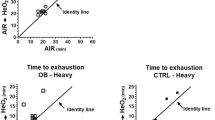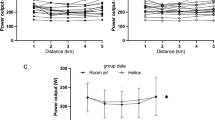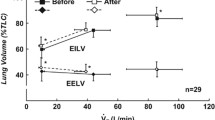Abstract
Purpose
In obesity, an increased work of breathing contributes to a higher O2 cost of exercise and negatively affects exercise tolerance. The purpose of the study was to determine whether, in obese adolescents, acute respiratory muscle unloading via normoxic helium–O2 breathing reduces the O2 cost of cycling and perceived exertion.
Methods
Nine males [age 16.8 ± 1.6 (x ± SD) years, body mass 109.9 ± 15.0 kg] performed on a cycle ergometer, breathing room air (AIR) or a 21 % O2–79 % helium mixture (He–O2): an incremental exercise, for determination of \( \mathop V\limits^{.} \)O2 peak and gas exchange threshold (GET); 12 min constant work rate (CWR) exercises at 70 % of GET (<GET) and 120 % of GET (>GET) determined in AIR.
Results
\( \mathop V\limits^{.} \)O2 peak was not different in the two conditions. From the 3rd to the 12th minute of exercise (both during CWR < GET and CWR > GET), \( \mathop V\limits^{.} \)O2 was lower in He–O2 vs. AIR (end-exercise values: 1.40 ± 0.14 vs. 1.57 ± 0.22 L min−1 <GET, and 2.23 ± 0.31 vs. 2.54 ± 0.27 L min−1 >GET). During CWR > GET in AIR, \( \mathop V\limits^{.} \)O2 linearly increased from the 3rd to the 12th minute of exercise, whereas no substantial increase was observed in He–O2. The O2 cost of cycling was ~10 % (<GET) and ~15 % (>GET) lower in He–O2 vs. AIR. Heart rate and ratings of perceived exertion for dyspnea/respiratory discomfort and leg effort were lower in He–O2.
Conclusions
In obese adolescents, acute respiratory muscle unloading via He–O2 breathing lowered the O2 cost of cycling and perceived exertion during submaximal moderate- and heavy-intensity exercise.





Similar content being viewed by others
Abbreviations
- AIR:
-
Ambient air
- ANOVA:
-
Analysis of variance
- BM:
-
Body mass
- BMI:
-
Body mass index
- COPD:
-
Chronic obstructive pulmonary disease
- CWR:
-
Constant work rate
- ECG:
-
Electrocardiography
- FEV1 :
-
Forced expiratory volume in 1 s
- FFM:
-
Fat-free mass
- FM:
-
Fat mass
- fR:
-
Respiratory frequency
- FVC:
-
Forced vital capacity
- GET:
-
Gas exchange threshold
- He–O2 :
-
Helium (79 %)–oxygen (21 %) gas mixture
- HR:
-
Heart rate
- PEFR:
-
Peak expiratory flow rate
- PET:
-
End-tidal partial pressure
- RPE:
-
Ratings of perceived exertion
- SD:
-
Standard deviation
- SDS:
-
Standard deviation score
- TI:
-
Time of inspiration
- TI/TT:
-
Duty cycle of inspiration
- TT:
-
Total time of inspiration and expiration
- \( \mathop V\limits^{.} \)CO2 :
-
CO2 output
- \( \mathop V\limits^{.} \)E:
-
Pulmonary ventilation
- \( \mathop V\limits^{.} \)O2 :
-
O2 uptake
- V T :
-
Tidal volume
References
Aliverti A, Quaranta M, Chakrabarti B, Albuquerque ALP, Calverley PM (2009) Paradoxical movement of the lower rib cage at rest and during exercise in COPD patients. Eur Resp J 33:49–60
Åstrand PO, Rodhal K, Dahl H, Strømme SB (2003) Textbook of work physiology. Physiological bases of exercise, 4th edn. Human Kinetics, Champaign
Babb TG (1999) Mechanical ventilator constraints in aging, lung disease and obesity: perspectives and a brief review. Med Sci Sports Exerc 31(Suppl):S12–S22
Babb TG, Ranasinghe KG, Comeau LA, Semon TL, Schwartz B (2008) Dyspnea on exertion in obese women: association with an increased oxygen cost of breathing. Am J Respir Crit Care Med 178:116–123
Babcock MA, Pegelow DF, Harms CA, Dempsey JA (2002) Effects of respiratory muscle unloading on exercise-induced diaphragm fatigue. J Appl Physiol 93:201–206
Beaver WL, Wasserman K, Whipp BJ (1986) A new method for detecting anaerobic threshold by gas exchange. J Appl Physiol 60:2020–2027
Bernhardt V, Wood HE, Moran RB, Babb TG (2013) Dyspnea on exertion in obese men. Respir Physiol Neurobiol 185:241–248
Borg G (1998) Borg’s perceived exertion and pain scales. Human Kinetics, Champaign
Brice AG, Welch HG (1983) Metabolic and cardiorespiratory responses to He–O2 breathing during exercise. J Appl Physiol 54:387–392
Cacciari E, Milani S, Balsamo A, Spada E, Bona G, Cavallo L, Cerutti F, Gargantini L, Greggio N, Tonini G, Cicognani A (2006) Italian cross-sectional growth charts for height, weight and BMI (2 to 20 year). J Endocrinol Invest 29:581–593
Carra J, Candau R, Keslacy S, Giolbas F, Borrani F, Millet GP, Varray A, Ramonatxo M (2003) Addition of inspiratory resistance increases the amplitude of the slow component of O2 uptake kinetics. J Appl Physiol 94:2448–2455
Chiappa GR, Queiroga F Jr, Meda E, Ferreira LF, Diefenthaeler F, Nunes M, Vaz MA, Machado MC, Nery LE, Neder JA (2009) Heliox improves oxygen delivery and utilization during dynamic exercise in patients with chronic obstructive pulmonary disease. Am J Respir Crit Care Med 179:1004–1010
Chlif M, Keochkerian D, Feki Y, Vaidie A, Choquet D, Ahmadi S (2007) Inspiratory muscle activity during incremental exercise in obese men. Int J Ob 31:1456–1463
Cleland SM, Murias JM, Kowalchuck JM, Paterson DH (2012) Effects of prior heavy-intensity exercise on oxygen uptake and muscle deoxygenation kinetics of a subsequent heavy-intensity cycling and knee-extension exercise. Appl Physiol Nutr Metab 37:138–148
Coast JR, Rasmussen SA, Krause KM, O’Kroy JA, Loy RA, Rhodes J (1993) Ventilatory work and oxygen consumption during exercise and hyperventilation. J Appl Physiol 74:793–798
Cole TJ, Freeman JV, Preece MA (1998) British 1990 growth reference centiles for weight, height, body mass index and head circumference fitted by maximum penalized likelihood. Stat Med 17:407–429
Cross TJ, Morris NR, Haseler LJ, Schneider DA, Sabapathy S (2010a) The influence of breathing mechanics on the development of the slow component of O2 uptake. Respir Physiol Neurobiol 173:125–131
Cross TJ, Sabapathy S, Schneider DA, Haseler LJ (2010b) Breathing He–O2 attenuates the slow component of O2 uptake kinetics during exercise performed above the respiratory compensation threshold. Exp Physiol 95:172–183
Esposito F, Ferretti G (1997) The effects of breathing He–O2 mixtures on maximal oxygen consumption in normoxic and hypoxic men. J Physiol 503:215–221
Gaesser GA, Poole DC (1996) The slow component of oxygen uptake kinetics in humans. Exerc Sport Sci Rev 24:35–71
Gray DS, Bray GA, Gemayel N, Kaplan K (1989) Effects of obesity on bioelectrical impedance. Am J Clin Nutr 50:255–260
Guenette JA, Querido JS, Eves ND, Chua R, Sheel AW (2009) Sex differences in the resistive and elastic work of breathing during exercise in endurance-trained athletes. Am J Physiol Regul Integr Comp Physiol 297:R166–R175
Harms CA, Babcock MA, McClaran SR, Pegelow DF, Nickele GA, Nelson WB, Dempsey JA (1997) Respiratory muscle work compromises leg blood flow during maximal exercise. J Appl Physiol 82:1573–1583
Hess DR, Fink JB, Venkataraman ST, Kim IK, Myers TR, Tano BD (2006) The history and physics of heliox. Respir Care 51:608–612
Hogan MC, Richardson RS, Haseler LJ (1999) Human muscle performance and PCr hydrolysis with varied inspired oxygen fractions: a 31P-MRS study. J Appl Physiol 86:1367–1373
Jones AM, Grassi B, Christensen PM, Krustrup P, Bangsbo J, Poole DC (2011) The slow component of \( \mathop V\limits^{.} \)O2 kinetics: mechanistic bases and practical applications. Med Sci Sports Exerc 43:2046–2062
Knudson RJ, Lebowitz MD, Holberg J, Burrows B (1983) Changes in the normal maximal expiratory flow-volume curve with growth and aging. Am Rev Respir Dis 127:725–734
Lamarra N, Whipp BJ, Ward SA, Wasserman K (1987) Effect of interbreath fluctuations on characterizing exercise gas exchange kinetics. J Appl Physiol 62:2003–2012
Lin CK, Lin CC (2012) Work of breathing and respiratory drive in obesity. Respirology 17:402–411
Louvaris Z, Zakynthinos S, Aliverti A, Habazettl H, Vasilopolou M, Andrianopoulos V, Wagner H, Wagner PD, Vogiatzis I (2012) Heliox increases quadriceps muscle oxygen delivery during exercise in COPD patients with and without dynamic hyperinflation. J Appl Physiol 113:1012–1023
Lukaski HC, Bolonchuk WW, Hall CB, Siders WA (1986) Validation of tetrapolar bioelectrical measurements to assess human body composition. J Appl Physiol 60:1327–1332
Mendelson M, Michallet A-S, Estève F, Perrin C, Levy P, Wuyam B, Flore P (2012) Ventilatory responses to exercise training in obese adolescents. Respir Physiol Neurobiol 184:73–79
Miller MR, Hankinson J, Brusasco V, Burgos F, Casaburi R, Coates A, Crapo R, Enright P, Van Der Grinten CPM, Gustafsson P, Jensen R, MacIntyre N, McKay R, Navajas D, Pedersen OF, Pellegrino R, Viegi G, Wanger J (2005) Standardisation of spirometry. Eur Respir J 26:319–338
Murphy TM, Clark WH, Buckingham IPB, Young WA (1969) Respiratory gas exchange in exercise during helium-oxygen breathing. J Appl Physiol 26:303–307
Ofir D, Laveneziana P, Webb KA, O’Donnell DE (2007) Ventilatory and perceptual responses to cycle exercise in obese women. J Appl Physiol 102:2217–2226
Powers SK, Jacques M, Richard R, Beadle RE (1986) Effects of breathing a normoxic He–O2 gas mixture on exercise tolerance and \( \mathop V\limits^{.} \)O2 max. Int J Sports Med 7:217–221
Romer LM, Lovering AT, Haverkamp HC, Pegelow DF, Dempsey JA (2006) Effect of inspiratory muscle work on peripheral fatigue of locomotor muscles in healthy humans. J Physiol 571:425–439
Salvadego D, Lazzer S, Busti C, Galli R, Agosti F, Lafortuna C, Sartorio A, Grassi B (2010) Gas Exchange kinetics in obese adolescents. Inferences on exercise tolerance and prescription. Am J Physiol Regul Int Comp Physiol 299:R1298–R1305
Vogiatzis I, Habazettl H, Aliverti A, Athanasopoulos D, Louvaris Z, Lo Mauro A, Wagner H, Roussos C, Wagner PD, Zakynthinos S (2011) Effect of helium breathing on intercostal and quadriceps muscle blood flow during exercise in COPD patients. Am J Physiol Regul Integr Comp Physiol 300:1549–1559
Wasserman K, Whipp BJ (1975) Exercise physiology in health and disease. Am Rev Respir Dis 112:219–249
Wetter TJ, Harms CA, Nelson WB, Pegelow DF, Dempsey JA (1999) Influence of respiratory muscle work on \( \mathop V\limits^{.} \)O2 and leg blood flow during submaximal exercise. J Appl Physiol 87:643–651
Whipp BJ, Rossiter HB, Ward SA (2002) Exertional oxygen uptake kinetics: a stamen of stamina? Biochem Soc Trans 30:237–247
Zoladz JA, Gladden LB, Hogan MC, Nieckarz Z, Grassi B (2008) Progressive recruitment of muscle fibers is not necessary for the slow component of \( \mathop V\limits^{.} \)̇O2 kinetics. J Appl Physiol 105:575–580
Acknowledgments
Financial support by Progetti di Ricerca Corrente, Italian Institute for Auxology, Milan is acknowledged.
Conflict of interest
No conflict of interest is reported.
Author information
Authors and Affiliations
Corresponding author
Additional information
Communicated by David C. Poole.
Rights and permissions
About this article
Cite this article
Salvadego, D., Sartorio, A., Agosti, F. et al. Acute respiratory muscle unloading by normoxic helium–O2 breathing reduces the O2 cost of cycling and perceived exertion in obese adolescents. Eur J Appl Physiol 115, 99–109 (2015). https://doi.org/10.1007/s00421-014-2993-8
Received:
Accepted:
Published:
Issue Date:
DOI: https://doi.org/10.1007/s00421-014-2993-8




